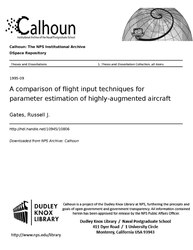File:A comparison of flight input techniques for parameter estimation of highly-augmented aircraft (IA acomparisonoffli1094510806).pdf

Original file (1,275 × 1,650 pixels, file size: 5.19 MB, MIME type: application/pdf, 119 pages)
Captions
Captions
Summary[edit]
| A comparison of flight input techniques for parameter estimation of highly-augmented aircraft
( |
||
|---|---|---|
| Author |
Gates, Russell J. |
|
| Title |
A comparison of flight input techniques for parameter estimation of highly-augmented aircraft |
|
| Description |
Parameter estimation is an inverse process in which stability derivatives are determined from time history flight data by matching the aircraft mathematical model's computed response with the measured response of the aircraft. Accurate parameter estimation depends mainly on instrumentation and input technique. Input technique is the focus of this thesis in which both classical inputs and optimal inputs were applied under the same flight conditions to the High Angle of Attack Research Vehicle (HARV) at NASA Dryden Flight Research Center. Post flight parameter estimation was conducted in all cases using a maximum likelihood technique to determine estimated of stability and control derivatives and their respective Cramer-Rao bounds. The Cramer-Rao bound is the most useful measure of estimate accuracy when comparing results from different input techniques assuming the same mathematical model and minimization technique were used for the parameter estimates. Comparison of the Cramer-Rao bounds showed that of the four input techniques used for determining parameter estimates, the Dryden single-surface input technique yielded the most accurate parameters for 75 percent of the estimates in all cases. Application of these conclusions in further research can save time and costs. Subjects: Aerodynamics. |
|
| Language | English | |
| Publication date |
September 1995 publication_date QS:P577,+1995-09-00T00:00:00Z/10 |
|
| Current location |
IA Collections: navalpostgraduateschoollibrary; fedlink |
|
| Accession number |
acomparisonoffli1094510806 |
|
| Source | ||
| Permission (Reusing this file) |
This publication is a work of the U.S. Government as defined in Title 17, United States Code, Section 101. As such, it is in the public domain, and under the provisions of Title 17, United States Code, Section 105, may not be copyrighted. | |
Licensing[edit]
| Public domainPublic domainfalsefalse |
This work is in the public domain in the United States because it is a work prepared by an officer or employee of the United States Government as part of that person’s official duties under the terms of Title 17, Chapter 1, Section 105 of the US Code.
Note: This only applies to original works of the Federal Government and not to the work of any individual U.S. state, territory, commonwealth, county, municipality, or any other subdivision. This template also does not apply to postage stamp designs published by the United States Postal Service since 1978. (See § 313.6(C)(1) of Compendium of U.S. Copyright Office Practices). It also does not apply to certain US coins; see The US Mint Terms of Use.
|
 | |
| This file has been identified as being free of known restrictions under copyright law, including all related and neighboring rights. | ||
https://creativecommons.org/publicdomain/mark/1.0/PDMCreative Commons Public Domain Mark 1.0falsefalse
File history
Click on a date/time to view the file as it appeared at that time.
| Date/Time | Thumbnail | Dimensions | User | Comment | |
|---|---|---|---|---|---|
| current | 21:40, 13 July 2020 |  | 1,275 × 1,650, 119 pages (5.19 MB) | Fæ (talk | contribs) | FEDLINK - United States Federal Collection acomparisonoffli1094510806 (User talk:Fæ/IA books#Fork8) (batch 1993-2020 #5223) |
You cannot overwrite this file.
File usage on Commons
The following page uses this file:
Metadata
This file contains additional information such as Exif metadata which may have been added by the digital camera, scanner, or software program used to create or digitize it. If the file has been modified from its original state, some details such as the timestamp may not fully reflect those of the original file. The timestamp is only as accurate as the clock in the camera, and it may be completely wrong.
| Short title |
|
|---|---|
| Author | Gates, Russell J. |
| Date and time of digitizing | 18:54, 21 January 2003 |
| Software used | LuraDocument PDF Compressor Server 5.7.66.46 (original: tif_convert_2_ps()) |
| File change date and time | 03:56, 22 January 2013 |
| Date metadata was last modified | 03:56, 22 January 2013 |
| Conversion program | Adobe Acrobat 9.52 Paper Capture Plug-in |
| Encrypted | no |
| Page size | 612 x 792 pts (letter) |
| Version of PDF format | 1.4 |

